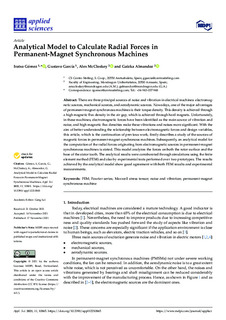
Izenburua
Analytical Model to Calculate Radial Forces in Permanent-Magnet Synchronous MachinesArgitalpen data
2021Ikerketa taldea
Accionamientos aplicados a la tracción y a la generación de energía eléctricaAcústica y vibraciones
Beste erakundeak
CS Centro Stirling, S.Coop.Bertsioa
Bertsio argitaratuaDokumentu-mota
ArtikuluaArtikuluaHizkuntza
IngelesaEskubideak
© 2021 by the authors. Licensee MDPISarbidea
Sarbide irekiaArgitaratzailearen bertsioa
https://doi.org/10.3390/app112210865Non argitaratua
Applied Sciences Vol. 11. N. 22. N. artículo 10865, 2021Argitaratzailea
MDPIGako-hitzak
FEM
Fourier series
Maxwell stress tensor
noise and vibration ... [+]
Fourier series
Maxwell stress tensor
noise and vibration ... [+]
FEM
Fourier series
Maxwell stress tensor
noise and vibration
permanent-magnet synchronous machine [-]
Fourier series
Maxwell stress tensor
noise and vibration
permanent-magnet synchronous machine [-]
Laburpena
There are three principal sources of noise and vibration in electrical machines: electromagnetic sources, mechanical sources, and aerodynamic sources. Nowadays, one of the major advantages of permanen ... [+]
There are three principal sources of noise and vibration in electrical machines: electromagnetic sources, mechanical sources, and aerodynamic sources. Nowadays, one of the major advantages of permanent-magnet synchronous machines is their torque density. This density is achieved through a high magnetic flux density in the air gap, which is achieved through hard magnets. Unfortunately, in these machines, electromagnetic forces have been identified as the main source of vibration and noise, and high magnetic flux densities make these vibrations and noises more significant. With the aim of better understanding the relationship between electromagnetic forces and design variables, this article, which is the continuation of previous work, firstly describes a study of the sources of magnetic forces in permanent-magnet synchronous machines. Subsequently, an analytical model for the computation of the radial forces originating from electromagnetic sources in permanent-magnet synchronous machines is stated. This model analyzes the forces on both the rotor surface and the base of the stator tooth. The analytical results were corroborated through simulations using the finite element method (FEM) and also by experimental tests performed over two prototypes. The results achieved by the analytical model show good agreement with both FEM results and experimental measurements. [-]
Bildumak
Item honek honako baimen-fitxategi hauek dauzka asoziatuta:





















